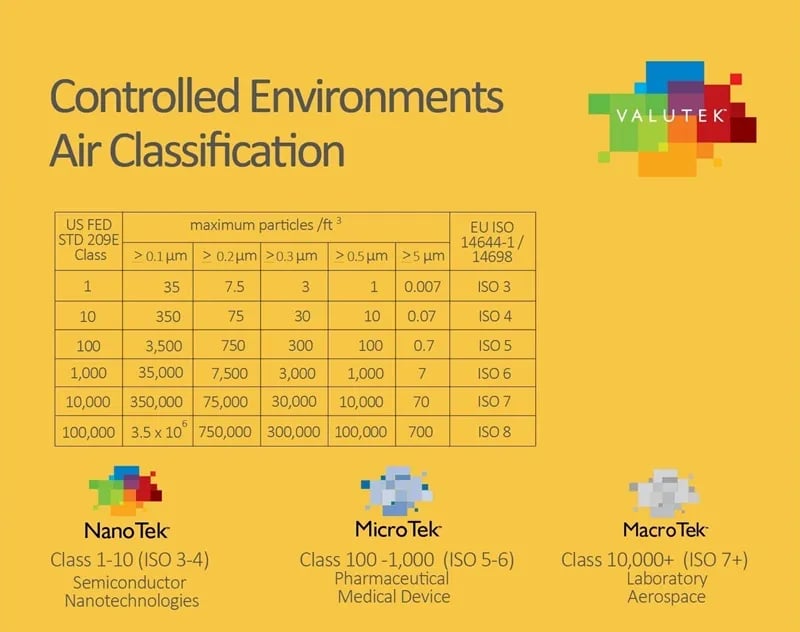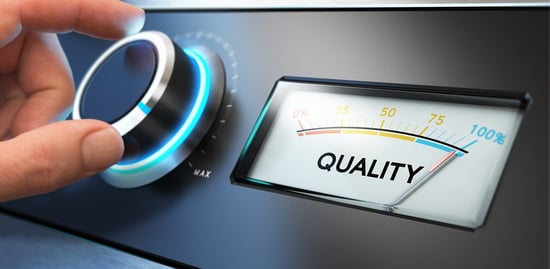Cleanroom managers and operators often use Federal Standard 209E cleanroom standards and ISO 14644-1 interchangeably when discussing or describing the requirements for their facility. But which is the correct standard and why?
In this article, we’ll provide an overview of the background and differences of these two cleanroom standards and how you can consider them in your selecting your most critical cleanroom products.
Which Came First, Federal Standard 209E or ISO?
In the early 1960s, thousands of cleanrooms were developed for NASA’s space program. The U.S. government needed to establish a standard for controlling airborne particles in these facilities. U.S.
Federal Standard 209E, Airborne Particulate Cleanliness Classes in Cleanrooms and Clean Zones, was the foundational standard that industries adopted at the time to distinguish their cleanrooms – with escalating levels of Class 1, 10, 100, 1,000, 10,000, and 100,000 – from a general clean room.
Cleanroom operations expanded in the U.S. and internationally, evolving with industry and consumer needs, government oversight and regulation, and technological advancements.
In the early 1990s, the International Organization for Standardization (ISO) established the technical committee to define international cleanroom standards. Compliance with the ISO standards (e.g. ISO 3, 4, 5, 7, 8) is mandatory to receive the required government agency product approval in regulated industries such as pharmaceuticals and medical device manufacturing.
Compliance with the standards in non-regulated industries, such as advanced materials, semiconductors and optics, is at the discretion of each user. Production yields, product quality and other market forces determine to what extent a non-regulated industry complies.
At-a-Glance
|
Federal Standard 209 |
ISO |
|
|
Governing body |
U.S. Federal Government |
Independent, international organization |
|
Year established/published |
1962 |
1993 |
|
Coverage |
United States |
>165 countries including the U.S. |
|
Standards reviewed and maintained by a governing body |
No |
Yes |
Which is the Most Current, 209E or ISO?
In 2001, ISO 14644-1 formally replaced the U.S. Federal Standard 209E. Today, ISO 14644 provides the internationally accepted cleanroom standards on air classifications that distinguish a cleanroom from a generic room that is a clean, controlled environment.
Which is more stringent, Federal Standard 209E or ISO?
They are the same. Both set levels of maximum air particles by particle size per cubic foot.

Which One Should We Comply With and Reference?
Standard 209E is no longer reviewed and maintained by the U.S. government while ISO is reviewed and maintained by an independent, international body with worldwide support and adoption. Cleanrooms designed, built and operated before the early 2000s may still use legacy language around Federal Standard 209E cleanroom standards and its levels: Class 1, 10, 100, 1,000, 10,000 and 100,000. Newer cleanrooms – or cleanrooms that have had their SOPs updated – now use ISO and its levels: 3, 4, 5, 6, 7 and 8. 209E provided a “national” standard in the US early on during the development of “cleanrooms,” but has now been replaced by the ISO “international” standard.
How Do 209E and ISO Cleanroom Standards Apply to Critical Gloves and Wipers?
209E and ISO 14644-1 set cleanliness only in terms of air particle size and concentration standards. There are a few key considerations to account for when selecting gloves and wipers, and how they’ll interact with your cleanroom’s standard:
Particle emission sources from cleanroom gloves:
- Particle emissions from glove substrates: Gloves should be made of vinyl, latex or nitrile substrates that meet acceptable upper and lower limits of particle and extractable emissions.
- Skin not encapsulated: If the gloves are uncomfortable, cleanroom personnel will have a harder time donning and wearing the gloves properly during their shift.
- Glove failure: Poor glove quality and durability expose can an operator’s skin and skin cell shedding.
Particle emission sources from cleanroom wipers:
- Particle emissions from wiper substrates: The substrates offering the highest levels of cleanliness are synthetic substrates of nylon, microfiber and polyester. Wiper substrates with natural materials of poly/cellulose blend or cotton offer superior absorbency but inferior cleanliness.
- Particle emissions from edge treatments: Wiper substrates are knife-cut to the appropriate size, then seals are applied to the edges to reducing particle shedding of the finished wiper. Common edge treatments to reduce particle counts from the cut edges are laser seal, ultrasonic seal, and pressure heat seal. Pressure heat seal is the cleanest because the edge is finished using heat and pressure to form the border of the wiper before being ultrasonically sealed.
Considering Air Particles Is A Starting Point In Critical Product Selection.
Reviewing particle emissions is a starting point for cleanroom glove and wiper selection. There are several other selection criteria that will be very important to your specific process and application:
- ESD: Are your products and processes sensitive to electrostatic discharge (ESD)?
- Chemical resistance: Are chemicals used in your cleanroom that will contact the gloves?
- Contamination from glove additives: Is your glove manufacturer adding fillers, accelerators and pigments that are sources of contaminants and allergens to its glove formulations?
- Wiper absorbency: Does your wiper meet absorbency requirements? Have you considered pre-saturated wipers for operational efficiency and cleaning efficacy?
Valutek offers a cleanroom classification grouping – Macrotek, Microtek and Nanotek – for its gloves, wipers, apparel and other cleanroom products to start your selection off right.
Our customer service team specializes in guiding you to the best product for compatibility with your cleanroom classification and process application.
Whether you reference your environment as a Class 10 / ISO 4, or a Class 10,000 / ISO 7, make sure the products used are the right fit to maintain your standard.
Follow us on LinkedIn for cleanroom tips.
Explore More Resources:
Navigation Cleanroom Standards: 5 Part Technical Series
Cleanroom Classification
Cleanroom Glove Selection Fundamentals - Part I : What You Need to Know
Cleanroom Glove Selection Fundamentals Part II: Cleanliness Requirements
Cleanroom Glove Selection Fundamentals Part III : Comfort Requirements

Valutek
Valutek is one of the first and few manufacturers to offer a full product portfolio of best-in-class cleanroom products. Since 1988, our controlled environment consumables are helping leading organizations operate their cleanrooms in a consistently stable state.
Related Articles
- Valutek

- 6 December 2023
From Matched Sets to Maximum Cleanliness: Gloves and Wipers in Focus
When it comes to matched sets of cleanroom products, gloves and wipers that are compatible with ...
- Valutek

- 11 May 2023
Why Repeatable, Standardized Testing is Important for Cleanroom Products
Companies establish cleanroom operating procedures based on internationally accepted standards to...
- Valutek

- 21 August 2023
When Does It Expire? Understanding Shelf Life of Cleanroom Consumables
When it comes to cleanroom consumables, a product’s recommended shelf life or specific expiration...


